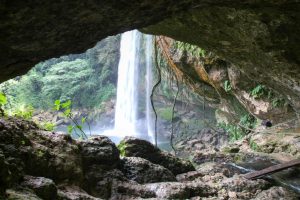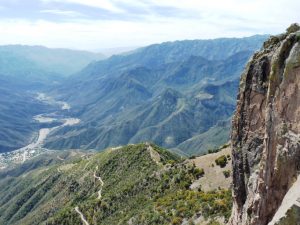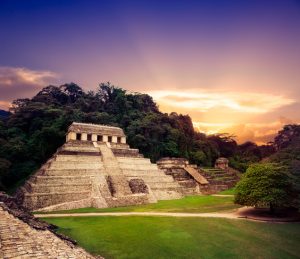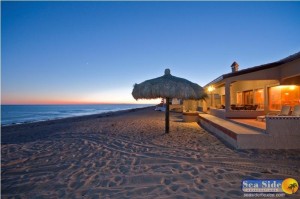 Thanks to its unique geographic location, Mexico is brimming with magnificent natural wonders, from forest-covered valleys to desert canyons and magical cenotes filled with turquoise, mineral-rich waters. This amazing diversity in landscapes includes dozens of breathtaking waterfalls, some of them plunging hundreds of feet over sheer rock faces.
Thanks to its unique geographic location, Mexico is brimming with magnificent natural wonders, from forest-covered valleys to desert canyons and magical cenotes filled with turquoise, mineral-rich waters. This amazing diversity in landscapes includes dozens of breathtaking waterfalls, some of them plunging hundreds of feet over sheer rock faces.
If you are inspired by the power of rushing water, try and plan a visit to at least one of these stunning cascades during your next vacation to Mexico!
Basaseachic Falls
Basaseachi earns the distinction as one of the highest waterfall in all of Mexico, second only to the Piedra Volada waterfall. Located in the state of Chihuahua, this impressive cascade looms 807 feet in the air, and remains one of the most popular attractions in the Copper Canyon. Basaseachi is fed by two rivers that dwindle during the fall and spring “dry seasons,” so plan a visit during the rainier months for a spectacular natural diplay.
Tzararácua Falls
One of the most famous natural attractions in Michoacan, the Tzararacua waterfall is an impressive site at more than 180 feet tall. Descend to the base of this gushing torrent of water on foot or by horseback, where you can camp out for the night. The area is perfect for hiking, birdwatching, and tour operators even offer waterfall rappelling and zip-line adventures.
Agua Azul Falls
A two-hour drive from Palenque, the Cascadas de Agua Azul (meaning Blue Water waterfalls), are nestled in the heart of verdant rainforest. What sets these falls apart from the pack are their gorgeous cerulean blue color, derived from a high mineral content. Various swimming holes invite visitors in for a refreshing dip beneath the cascading waters. Insiders tip: heavy rains from July-September churn up the silt, turning the normally clear aquamarine waters a tad muddy.
Misol-Há Falls
Jutting more than 100 feet skyward, the Misol Ha waterfall will blow you away with its otherworldly beauty. When you’re not posing for pictures, you can swim in the invitingly deep pool or explore a 20-meter long cavern that is tucked behind the falls. Misol Ha (which is Mayan for “waterfalls”) is an easy pit stop between Palenque and Agua Azul. Wear sturdy anti-slip shoes if you plan on exploring the waterfall cave or lush natural surroundings.
Cola de Caballo Falls
Cascada Cola de Caballo (meaning horse tail in Spanish) is situated in Villa de Santiago, roughly 30 miles from Monterrey. The aptly named 82-foot cascade fans out over jutting boulders before crashing into a deep pool beneath. A paved trail leads the way to the waterfall which is flanked by green forested cliffs and rugged rock formations. Enjoy a picnic lunch beneath the cooling spray of Cola de Caballo waterfall which has many viewing platforms for great photo opportunities.

 Mexico remains one of the most popular vacation destinations for families, friends and couples, attracting more than 20 million visitors each year. Boasting palm-fringed beaches, miles of turquoise waters, and adrenaline-pumping adventures at every turn, it’s no wonder so many Americans head south of the border for some much needed R&R.
Mexico remains one of the most popular vacation destinations for families, friends and couples, attracting more than 20 million visitors each year. Boasting palm-fringed beaches, miles of turquoise waters, and adrenaline-pumping adventures at every turn, it’s no wonder so many Americans head south of the border for some much needed R&R. Mexico is nation renowned for its breathtaking beaches, vibrant traditions, world-class sportfishing and palate-pleasing cuisine. But few tourists know that Mexico is home to nearly 200 sites created and inhabited by Mesoamerica’s most advanced civilization – the Maya. Celebrated for their impressive developments in mathematics, hieroglyph writing, astrology and architecture, the Maya civilization dominated southern Mexico and the Yucatan Peninsula as well as parts of Central America between 250 and 900 AD.
Mexico is nation renowned for its breathtaking beaches, vibrant traditions, world-class sportfishing and palate-pleasing cuisine. But few tourists know that Mexico is home to nearly 200 sites created and inhabited by Mesoamerica’s most advanced civilization – the Maya. Celebrated for their impressive developments in mathematics, hieroglyph writing, astrology and architecture, the Maya civilization dominated southern Mexico and the Yucatan Peninsula as well as parts of Central America between 250 and 900 AD. Destination weddings are becoming increasingly popular, as more couples discover the intrinsic benefits of celebrating their big day in an exotic, warm-weather locale. According to bridal authority TheKnot, Mexico ranks among the world’s top places for a destination wedding. Given the country’s amazing array of natural attractions, archeological ruins and stunning scenery, it’s no wonder why Mexico is the perfect place for couples who want a beautiful—yet affordable—beach wedding in paradise.
Destination weddings are becoming increasingly popular, as more couples discover the intrinsic benefits of celebrating their big day in an exotic, warm-weather locale. According to bridal authority TheKnot, Mexico ranks among the world’s top places for a destination wedding. Given the country’s amazing array of natural attractions, archeological ruins and stunning scenery, it’s no wonder why Mexico is the perfect place for couples who want a beautiful—yet affordable—beach wedding in paradise. Over the past decade, the Mexican beer scene has exploded, churning out a surprising number of highly drinkable cervezas artesanales – hoppy, full-bodied craft beers that can truly hold their own. If you’re hankering for something headier than Dos Equis, Pacifico, or the ubiquitous Corona, there are some exciting new brews to check out during your next trip south of the border. Some say that the craft beer movement in Mexico is still under the radar, limited to major urban hubs like Mexico City or Guadalajara.
Over the past decade, the Mexican beer scene has exploded, churning out a surprising number of highly drinkable cervezas artesanales – hoppy, full-bodied craft beers that can truly hold their own. If you’re hankering for something headier than Dos Equis, Pacifico, or the ubiquitous Corona, there are some exciting new brews to check out during your next trip south of the border. Some say that the craft beer movement in Mexico is still under the radar, limited to major urban hubs like Mexico City or Guadalajara. Golf aficionados owe it themselves to head south of the border and experience the magic of premier golf in Mexico. A 2016 Golf Digest article waxes poetic on the “numerous” picturesque and highly playable courses, many positioned along gorgeous seaside cliffs. From the Baja Peninsula to Chileno Bay, the Mexican golf scene continues to garner international recognition for superb course designs by PGA champions like Nicklaus, Gary Player and Greg Norman.
Golf aficionados owe it themselves to head south of the border and experience the magic of premier golf in Mexico. A 2016 Golf Digest article waxes poetic on the “numerous” picturesque and highly playable courses, many positioned along gorgeous seaside cliffs. From the Baja Peninsula to Chileno Bay, the Mexican golf scene continues to garner international recognition for superb course designs by PGA champions like Nicklaus, Gary Player and Greg Norman. Looking for sun-drenched beaches and crystal-clear water? Mexico is a popular travel destination during the winter months, especially among surfers. Some of the best waves are found in Cabo San Lucas and Sayulita, Nayarit, but there are plenty of other choices to please every surfer, from beginner to expert. And if you have difficulty choosing just one destination, consider booking a tour of your favorite hot spots.
Looking for sun-drenched beaches and crystal-clear water? Mexico is a popular travel destination during the winter months, especially among surfers. Some of the best waves are found in Cabo San Lucas and Sayulita, Nayarit, but there are plenty of other choices to please every surfer, from beginner to expert. And if you have difficulty choosing just one destination, consider booking a tour of your favorite hot spots. The holiday season is winding down but there are still months of winter left ahead – presenting the perfect opportunity to escape to Mexico. Whether you just need a break from snowy weather, could use a time away to refresh after holiday preparations, or are just itching for some adventure and exploration, a winter vacation in Mexico offers just what many of us need.
The holiday season is winding down but there are still months of winter left ahead – presenting the perfect opportunity to escape to Mexico. Whether you just need a break from snowy weather, could use a time away to refresh after holiday preparations, or are just itching for some adventure and exploration, a winter vacation in Mexico offers just what many of us need. Who needs Times Square when there is a world of possibilities in sunny Mexico? This year, ditch the snow and the cold and head south for New Year’s. It’s easy to book a premier vacation rental at a resort town in Mexico. The hardest part of arranging your trip is figuring out which particular destination suits you best. Here’s a quick look at some of the possibilities for ringing in 2017.
Who needs Times Square when there is a world of possibilities in sunny Mexico? This year, ditch the snow and the cold and head south for New Year’s. It’s easy to book a premier vacation rental at a resort town in Mexico. The hardest part of arranging your trip is figuring out which particular destination suits you best. Here’s a quick look at some of the possibilities for ringing in 2017.